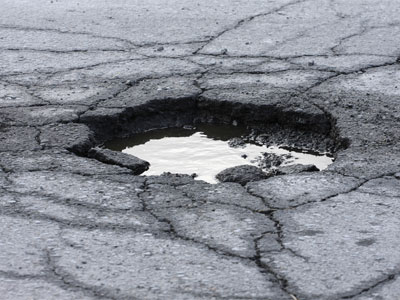
Winter is pothole season and this year, they are packing a powerful punch. After hitting a pothole, most drivers wonder, “Is my car OK?” While the tires and wheels can be visually inspected, there could be damage to the steering, suspension and alignment systems that you just can’t see. To help determine if hitting a pothole has damaged your vehicle, watch for the following warning signs.
- Loss of control, swaying when making routine turns, bottoming out on city streets or bouncing excessively on rough roads. These are indicators that the steering and suspension may have been damaged. The steering and suspension are key safety-related systems. Together, they largely determine your car’s ride and handling. Key components are shocks and/or struts, the steering knuckle, ball joints, the steering rack/box, bearings, seals and hub units and tie rod ends.
- Pulling in one direction, instead of maintaining a straight path, and uneven tire wear. These symptoms mean there’s an alignment problem. Proper wheel alignment is important for the lifespan of tires and helps ensure safe handling.
- Low tire pressure, bulges or blisters on the sidewalls, or dents in the rim. These problems will be visible and should be checked out as soon as possible as tires are the critical connection between your car and the road in all sorts of driving conditions.
Snow, cold temperatures and rainfall can lead to potholes, and with the wintery weather that has covered most of the country this year, navigating the streets could be difficult. If you have hit a pothole and suspect that there may be damage to the tires, wheels, steering and suspension or wheel alignment, it’s worth having a professional technician check out the car and make any necessary repairs.
As a general rule of thumb, steering and suspension systems should be checked at least once a year and wheels should be aligned at the same interval. Motorists who live in areas where potholes are common should be prepared to have these systems checked more frequently.
Potholes occur during the winter and spring months, when water permeates the pavement - usually through a crack from wear and tear of traffic - and softens the soil beneath it, creating a depression in the surface of the street. Many potholes appear during winter and spring months because of freeze-thaw cycles, which accelerate the process. Potholes can also be prevalent in areas with excessive rainfall and flooding.